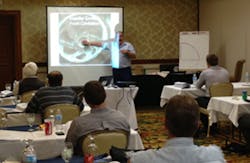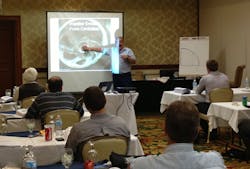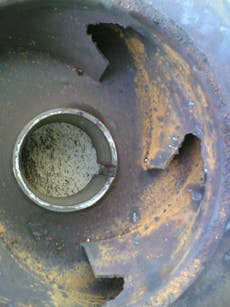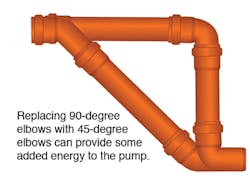During this week’s Pump Guy Seminar in Chicago, Larry Bachus (a.k.a. “The Pump Guy”) explained how 85 percent of pump cavitation problems can be alleviated by employing some basic pumping systems fundamentals. Want to know how? Read on.
Bachus says there are two primary types of cavitation that impact pumping systems:
1. Vaporization Cavitation; and
2. Internal Recirculation Cavitation
According to Bachus, vaporization cavitation accounts for nearly 70 percent of all cavitation cases, with internal recirculation cavitation accounting for 15 percent of cases.
Vaporization
Recirculation
Vaporization Cavitation
Bachus says the key to solving vaporization cavitation is ensuring the NPSHa (Net Positive Suction Head available) is greater than the NPSHr (Net Positive Suction Head required) plus three feet of head for safety margin … “And there’s nothing wrong with five feet or more as a safety margin,” he says.
Sounds easy enough, but if you’re dealing with a system in which the NPSHa is lacking, how can you find that extra oomph on the suction side of the pump? Well, Bachus says there are some common, and simple, ways you can find more energy (or NPSHa) on the suction side of your system.
For example, you could increase flow by looking at the suction pipe to make sure all of the suction valves are totally wide open. It is common practice to partially close a valve on startup until the system comes up to temperature, because if a hot system is started with the valve all the way open and the system temperature increases, it will be impossible to close the valves thereafter. In his experience, Bachus says he often finds those valves are never revisited and fully opened once the system does come up to temperature. Fully opening a few partially closed valves could make the difference between vaporization cavitation and no cavitation at all.
RELATED: 5 Interesting Things I Heard Today at the Pump Guy Seminar
RELATED: Have you registered for the Oct. 1-3 Pump Guy Seminar in Philly yet?
Another relatively easy fix is to clean and/or replace filters and strainers on the suction side of the pump. Or, if you’re draining a tank, don’t drain the tank too low, but rather keep some elevation in the tank to provide added suction energy on the pump.
If all options have been exhausted, and there is just no reasonable way to increase energy on the suction side of the pump, Bachus says you can also reduce the energy required (NPSHr) by pinching a valve on the discharge side of the pump.
Recirculation Cavitation
Recirculation cavitation occurs when there is a low-flow condition due to excessive resistance on the discharge side of the pump. So, while vaporization cavitation is caused by the pump operating to the right of the best efficiency zone on the pump curve, recirculation cavitation is caused by the pump operating to the left of its best efficiency zone.
Bachus says recirculation cavitation can often be addressed by ensuring all of the downstream isolation valves are totally open and that all of the downstream filters and strainers are clean and operating efficiently. Or, perhaps there is some debris (or a wrench) lodged in the downstream pipe. Or maybe a temporary witch hat strainer was never removed from the downstream piping.
Ultimately, Bachus says it is in the plant’s best interest to train the operators to understand the difference between vaporization cavitation and recirculation cavitation, as well as how to troubleshoot these two forms of cavitation. And while he acknowledges there are other forms of cavitation that require more complex troubleshooting, he says pump users can, on average, eliminate 85 percent of their cavitation problems by focusing on vaporization and recirculation.
Matt Migliore is the director of content for Flow Control magazine and FlowControlNetwork.com. He can be reached at 610.828.1711 or [email protected].






